<>
Combining Immunotherapy with Chemotherapy for Enhanced Effectiveness
Introduction
The combination of immunotherapy with chemotherapy represents a revolutionary approach in the fight against cancer. This synergistic treatment strategy aims to enhance the body’s immune response while simultaneously attacking cancer cells through traditional chemotherapy methods. The growing body of research suggests that this combination may lead to improved patient outcomes, increased survival rates, and reduced tumor growth. Understanding how combining immunotherapy and chemotherapy contributes to the broader category of immunotherapy for cancer is critical for patients, healthcare providers, and researchers alike.
Key Concepts
Several key concepts underpin the strategy of combining immunotherapy with chemotherapy:
- Mechanism of Action: Immunotherapy works by boosting the body’s natural defenses to target and destroy cancer cells, while chemotherapy directly kills rapidly dividing cells.
- Synergistic Effects: By combining these therapies, it’s possible to create a synergistic effect that enhances the overall effectiveness of cancer treatment.
- Immune Response Enhancement: Chemotherapy can increase the immunogenicity of tumors, making them more recognizable to the immune system when followed by immunotherapy.
Applications and Real-World Uses
Understanding how combining immunotherapy with chemotherapy is applied in clinical settings can clarify its role in enhancing cancer treatment:
- Mantle Cell Lymphoma: Studies have shown that the combination of chemotherapy drugs with checkpoint inhibitors has significantly improved outcomes in patients with this type of lymphoma.
- Non-Small Cell Lung Cancer: Research has demonstrated that combining chemotherapy with PD-1 inhibitors leads to better progression-free survival compared to chemotherapy alone.
- Bladder Cancer: Clinical trials indicate that using immunotherapy alongside chemotherapy can enhance the rate of complete pathological responses in muscle-invasive bladder cancer.
Current Challenges
While the combination therapy offers promising results, there are significant challenges that need to be addressed:
- Adverse Effects: The combined regimen may lead to increased toxicity and adverse side effects, complicating patient management.
- Patient Selection: Identifying which patients are most likely to benefit from combination therapy remains a challenge in clinical practice.
- Timing and Dosage: Determining the optimal sequencing and dosages for both therapies is still an area of active research.
Future Research and Innovations
The future of combining immunotherapy with chemotherapy is bright, with ongoing research focused on several key innovations:
- Biomarker Identification: Research aimed at identifying biomarkers for response prediction is crucial for personalizing treatment.
- Next-Gen Therapies: The development of next-generation immune checkpoint inhibitors and targeted therapies holds promise for enhanced efficacy when combined with chemotherapy.
- Combination Protocols: Ongoing trials are investigating new combinations and sequencing strategies that maximize treatment effectiveness while minimizing side effects.
Conclusion
In summary, combining immunotherapy with chemotherapy represents a significant advancement in cancer treatment, providing enhanced effectiveness and improved patient outcomes. As research continues to evolve, healthcare providers and researchers are better equipped to navigate this complex treatment landscape. For further exploration, please visit our articles on Immunotherapy Basics and Advances in Chemotherapy. Your journey towards understanding these innovative cancer treatments is just beginning!

